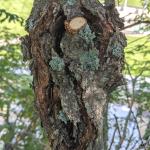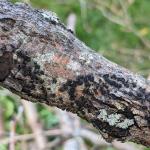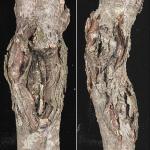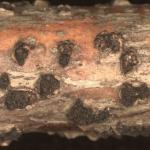Thyronectria Canker
Pathogen
The fungal pathogen Thyronectria austroamericana is responsible for Thyronectria canker. Thyronectria has a wide distribution in the United States but is somewhat uncommon in southern New England. It was first identified in Massachusetts at the Arnold Arboretum in the early 1930s (Seely 1940).
Hosts
The primary host is honeylocust (Gleditsia triacanthos). However, susceptibility varies among G. triacanthos cultivars. Occasional hosts include Japanese honeylocust (G. japonica) and mimosa (Albizia julibrissin).
Symptoms and Signs
Thyronectria can kill small diameter stems and create perennial cankers on larger branches and the main trunk. Cankers are often elongate and sunken with discolored bark and eruptive fruiting bodies. On younger branches, cankered bark may appear orange-brown to yellow-brown with cracked and peeling bark. Over many years, woundwood development around perennial cankers creates a rough, distorted appearance with splitting and sloughing bark. Black-colored clusters of fruiting bodies will rupture through dead bark to release large volumes of spores. These will be most apparent on smaller diameter stems and branches and should be visible without the aid of a hand lens. On larger branches and the main trunk, the fruiting bodies may be more difficult to locate. Infected trees may have shoots with yellowing and wilting leaves, scattered canopy dieback and epicormic sprouts when the dieback worsens.
Management
Trees that are stressed and weakened are more susceptible to cankering pathogens like Thyronectria. Stress in urban environments can be particularly conducive to disease development. Examples include compacted soils, limited rooting zone, drought, excessive heat, and mechanical injuries. Pruning wounds, branch crotches, and other injuries to the bark create infection points for Thyronectria. When the disease is present, prune and discard all cankered branches from the canopy. This physically removes the pathogen from the canopy so that it cannot sporulate and spread further, creating new infection sites. For trees with extensive infections, it may take several years of sanitation pruning to significantly reduce inoculum. In some cases, large and cankered branches may need to be retained, since their removal would be more detrimental to the health and aesthetics of the tree than the infection. Avoid pruning during mild and wet weather as this can help spread the pathogen. Sanitize pruning tools after working with plants that are known or suspected of being infected by Thyronectria. The fungus will continue to produce spores throughout the growing season, making it difficult to control once established.
For younger trees, fungicides may be effective at slowing disease progression and protecting newly developing plant parts from becoming infected. However, they may have little to no curative effect on infected stems and branches. Systemic fungicides like azoxystrobin, thiophanate-methyl and phosphites should be applied directly to the canker site. Contact fungicides like copper hydroxide and mancozeb could be used to protect newly developing shoots in the spring and early summer. They can also be applied over pruning wounds. Fungicide use is most practical after diseased branches are pruned from the canopy in an effort to reduce inoculum.
References
Seeler, E.V. 1940. Two diseases of Gleditsia caused by a species of Thyronectria. Journal of the Arnold Arboretum 21(3): 405–427.
Sinclair, W.A. and H.H. Lyon. 2005. Diseases of Trees and Shrubs, 2nd edn. Cornell University Press, Ithaca, NY.




